one of the worst game ever!!
With a long, sullied history of extremely poor DBZ games before it, Dragon Ball Z: Budokai was a bit of a revelation when it was released in 2002. Here was a 3D fighting game that, while not offering the deepest combat system, was still reasonably fun to play. Moreover, it featured a great story mode that basically summed up the entire run of the Dragon Ball Z manga-cum-anime in just a few hours. A year later, we got a sequel with improved cel-shaded graphics, but the slick story mode was replaced by a lame board game, and the additions made to the gameplay just didn't seem to mesh with what was already there. Dimps, the little-known developer responsible for the entire Budokai series, learned some lessons and has now returned to the scene with Dragon Ball Z: Budokai 3. This is far and away the best Dragon Ball Z game around, and it's a must-have for DBZ fans. However, the action is also so fast-paced and viscerally satisfying that it can genuinely appeal even to those otherwise uninterested in Dragon Ball Z.
This is the best Dragon Ball Z game to date.
The action in the Budokai games has never been particularly technical, and though Budokai 3 retains all the fundamentals, it adds several new gameplay mechanics that have significant impact on the action. The first is the new teleportation counter system, which, following a simple tap of the D pad and the X button at the right moment, will instantly teleport you right behind your opponent so you can deliver unto him or her a nice, crushing blow. If your opponent is quick enough on his or her feet, though, he or she can pull a reversal and teleport behind you, keeping this move from being an overpowered one. This little teleport maneuver can also be used to pop up behind your opponent after he or she has been knocked through the air, which lets you ping-pong him or her back and forth a few times. While this may sound like kind of an oddball mechanic to outsiders, Dragon Ball Z fans will recognize it as an integral part of just about any DBZ fight.
Also key to Dragon Ball Z are massive energy attacks, which the Budokai series has dutifully represented. Budokai 3 is the first entry in the series to introduce the concept of a "beam struggle," which basically involves two characters throwing a massive beam of energy at each other. Each then tries to overpower the other's beam. Once you find yourself locked in a beam struggle, all you need to do is rotate the analog sticks or mash on the buttons as fast as you can while hoping that you're faster than your opponent. Tactically, it's not a big deal, but it brings the gameplay experience that much closer to the source material. Also, some very heavy lighting and particle effects make the beam struggles look extremely cool.
Even if you don't like Dragon Ball Z, this game can be a lot of fun.
All of your energy-based moves use up ki, which is represented by a set of bars that are separate from your life-energy bar. You can fill up these bars just by connecting with your attacks, or if there's a lull in the action, you can stand still and power up, which fills your meter rapidly but exposes you to attacks. Keeping your ki meter full is of paramount importance, because your basic punch, kick, and grapple moves won't have as much of an effect when your ki meter is empty. Ki is also needed for transformations, such as when Frieza evolves through his different forms or when any of the Saiyans want to go into their blonde-hair, blue-eyed super-Saiyan mode. But probably the most important use of ki in Budokai 3 involves hyper mode. If you have enough ki (four bars will do), you can press all four face buttons to enter hyper mode. The intense red glow given off by characters in hyper mode is unmistakable, and when they're in this state, they have a few moves they can't execute otherwise.
The dragon rush is the most important move strategically, just because it comes into play more often than other moves. If you're in hyper mode and you have your opponent on the ropes, a well-timed press of the circle button will launch a dragon rush, which boils the rock-paper-scissors underpinning of all fighting games down to its very essence. The camera cuts from the usual side-profile position to give more-cinematic shots of the character that launched the dragon rush to unleash incredible pummeling attacks on his or her opponent. However, the attacker has to get a little lucky if he or she wants to do the most possible damage. At three points during the dragon rush, both players have to press one of the face buttons. If the attacker can avoid hitting the same button as the player being attacked at each of these intervals, the series of attacks will end with a punishing energy blast. If the button presses match up at any point, though, the defender can cancel out the dragon rush and go back to regular action. The action is so incredibly over-the-top, and the camera cuts so perfectly, that the dragon rush is mind-blowing the first time you see it. The downer is that the dragon rush is basically the same for every single character, though there are a few subtle permutations based on specific characters and specific environments. More variety would have been nice, but the dragon rushes are still fantastic additions to the action
all it is is crap

